Posted by: Northwest Eye in General on July 25, 2025
Overview
This article offers ten essential tips for effectively treating eyelid dermatitis, focusing on strategies that can truly make a difference. We understand that navigating this condition can be challenging, which is why we emphasize:
- Identifying allergens
- Establishing a gentle skincare routine
- Consulting with dermatologists
- Making thoughtful lifestyle changes
These recommendations, supported by expert insights, highlight the importance of personalized care. It’s common to feel overwhelmed, but avoiding irritants and maintaining hydration are crucial steps in managing symptoms and improving overall skin health. Remember, you are not alone in this journey, and we are here to help you through the process.
Introduction
Eyelid dermatitis can be a frustrating and uncomfortable condition. We understand that it is often exacerbated by allergens and irritants that many may not even realize they are exposed to. Understanding the intricacies of this skin issue is crucial for effective management and relief.
This article offers ten essential tips that empower you to navigate your treatment options. It also highlights the importance of personalized care and professional guidance.
What steps can you take to identify triggers and establish a successful skincare routine, all while ensuring long-term skin health? We are here to help you through this process.
Northwest Eye: Comprehensive Eyelid Dermatitis Management Services
At Northwest Eye, we understand that can be challenging to deal with. Our comprehensive approach combines advanced diagnostic tools with tailored treatment plans specifically for eyelid dermatitis treatment designed for you. Our team of experts is dedicated to addressing the various skin issues that can affect the area around your eyes, ensuring you receive the that meets your unique needs.
We believe in the power of . By empowering you to understand your condition and the treatment options available, we foster a collaborative approach to your eye health. It’s common to feel overwhelmed, but rest assured, we are here to support you every step of the way, helping you navigate this journey with confidence.
Identify Allergens: Recognize Common Triggers of Eyelid Dermatitis
We understand that dealing with can be frustrating and uncomfortable. Common allergens, such as cosmetics, skincare products, and like pollen or pet dander, may be the culprits behind your symptoms. Keeping a diary of your can be incredibly helpful in identifying specific allergens that affect you.
It’s common to feel overwhelmed by this process, but remember, you are not alone. can provide you with into pinpointing these irritants. Together, you can develop effective that will help you feel more comfortable and in control.
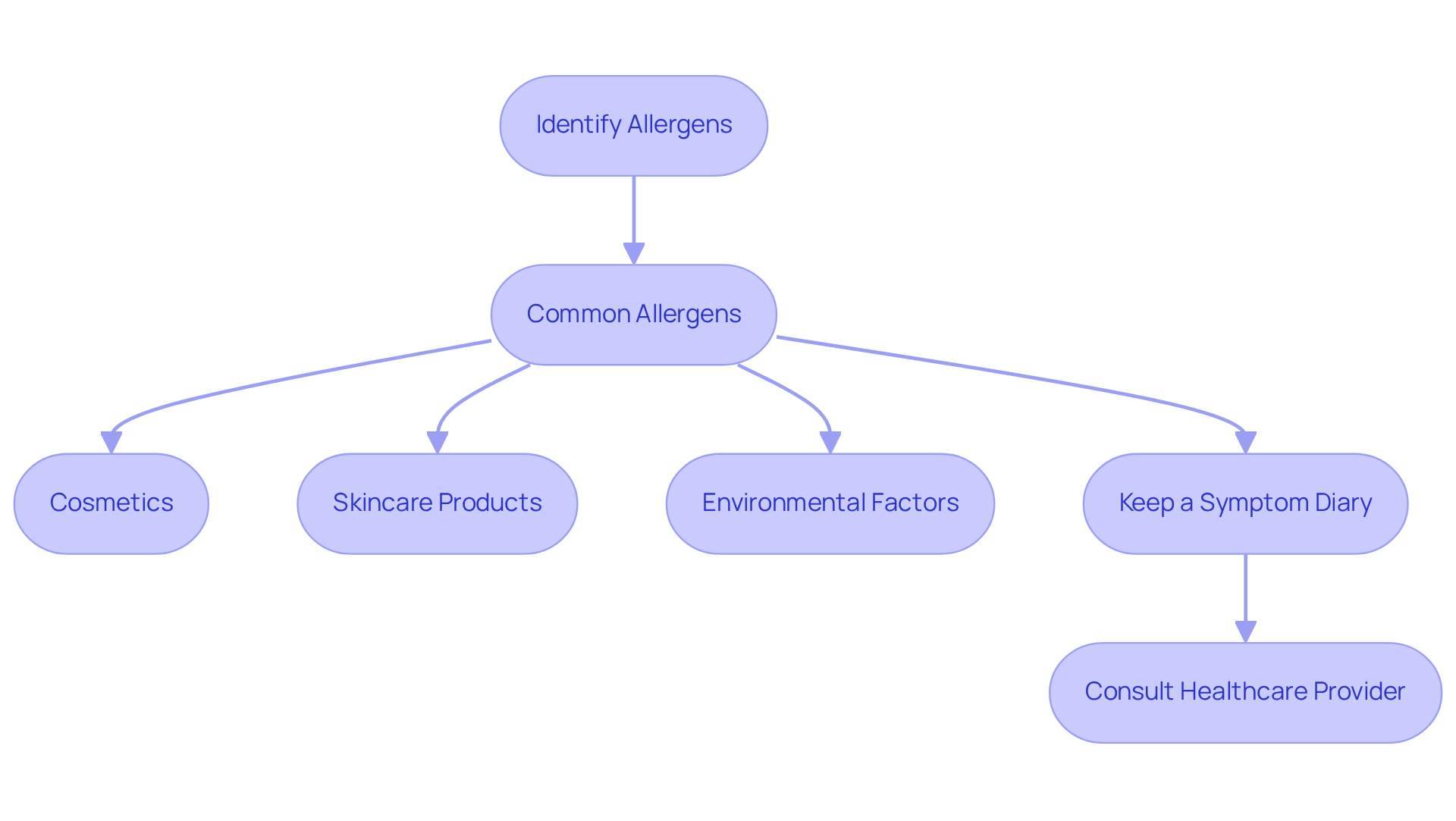
Establish a Gentle Skincare Routine: Best Practices for Eyelid Care
We understand that dealing with around the eyes can be challenging. To establish an efficient and , it is crucial to choose and moisturizers specifically formulated for delicate complexions. Harsh scrubs and exfoliants should be avoided, as they can worsen irritation and discomfort. Instead, consider incorporating a , which can significantly enhance and protect the surrounding your eyes.
Dermatologists emphasize that consistency in using to managing sensitivity and is essential for effective . By prioritizing these , you can effectively care for your eyes while reducing the likelihood of flare-ups. Remember, we are here to help you through this process, ensuring you feel supported every step of the way.
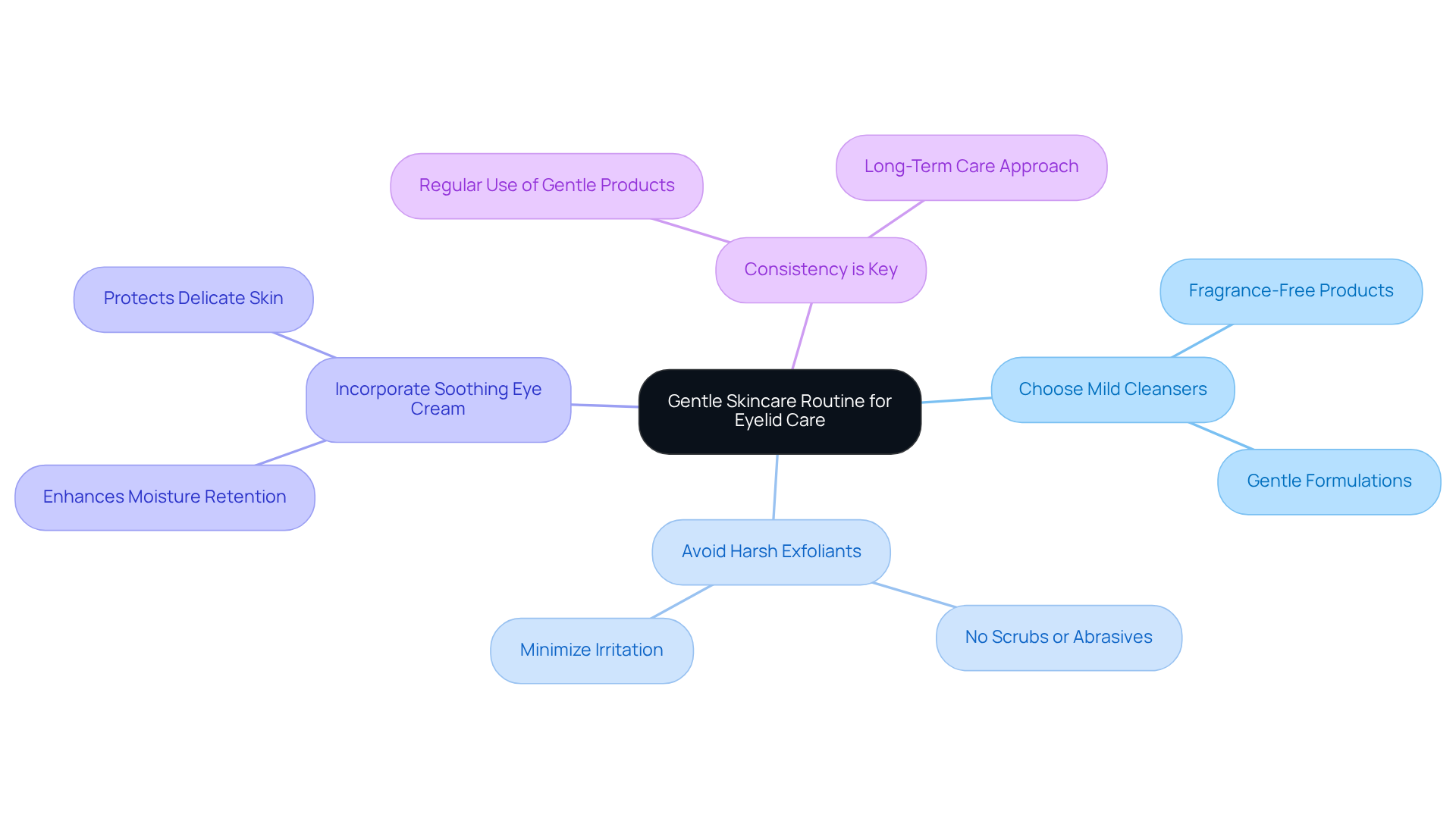
Consult Dermatologists: Seek Professional Advice for Tailored Treatment
Consulting a skin specialist is crucial for anyone seeking for inflammation around the eyes. We understand that this can be a challenging experience. These specialists can evaluate the severity of your condition and create . First-line eyelid dermatitis treatment may consist of emollients, , and .
Regular follow-ups are essential for monitoring your progress and making any necessary adjustments to your eyelid dermatitis treatment strategy. Dermatologists emphasize that the outcomes of eyelid dermatitis treatment. Many individuals have reported noticeable improvements in their symptoms through tailored approaches.
It’s common to feel concerned about possible complications from neglected eyelid irritation, such as keratitis and conjunctivitis. This highlights the importance of seeking . By prioritizing expert guidance, you can navigate your treatment journey with confidence. You will gain a better understanding of the causes, treat your symptoms, and , ensuring you receive the most effective care tailored to your unique needs. We are here to help you through this process.
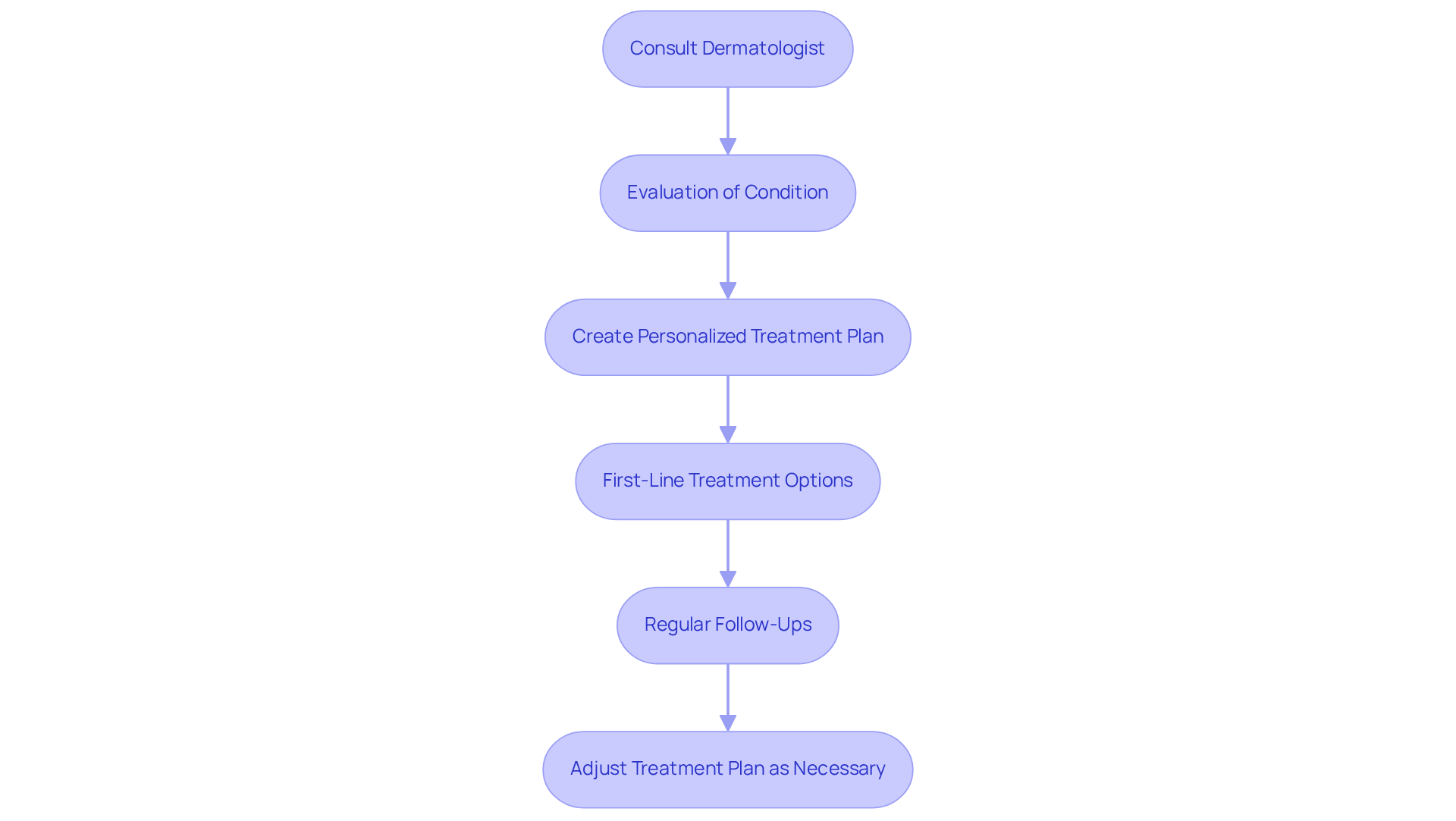
Utilize Topical Treatments: Effective Creams and Ointments for Relief
for play a vital role in managing symptoms and improving outcomes for those affected. We understand that dealing with this condition can be challenging, and are often prescribed to help and alleviate irritation. Research shows that these creams can lead to , with many individuals experiencing notable relief after consistent use.
For example, a clinical trial revealed that 80% of participants saw substantial improvement when using , a calcineurin inhibitor, demonstrating its effectiveness in managing moderate to severe cases. Furthermore, 94% of participants agreed on , which include topical calcineurin inhibitors and corticosteroids.
Experts emphasize the importance of , as responses to topical therapies can vary among patients. It’s common to feel uncertain about the best approach, but incorporating both and calcineurin inhibitors into a can enhance your quality of life.
However, it’s crucial to adhere to specific guidelines regarding the frequency and duration of these treatments to minimize potential side effects, such as skin thinning associated with prolonged corticosteroid use. Regular consultations with healthcare professionals ensure that you receive tailored guidance and necessary adjustments to your treatment as needed. We are here to help you through this process.
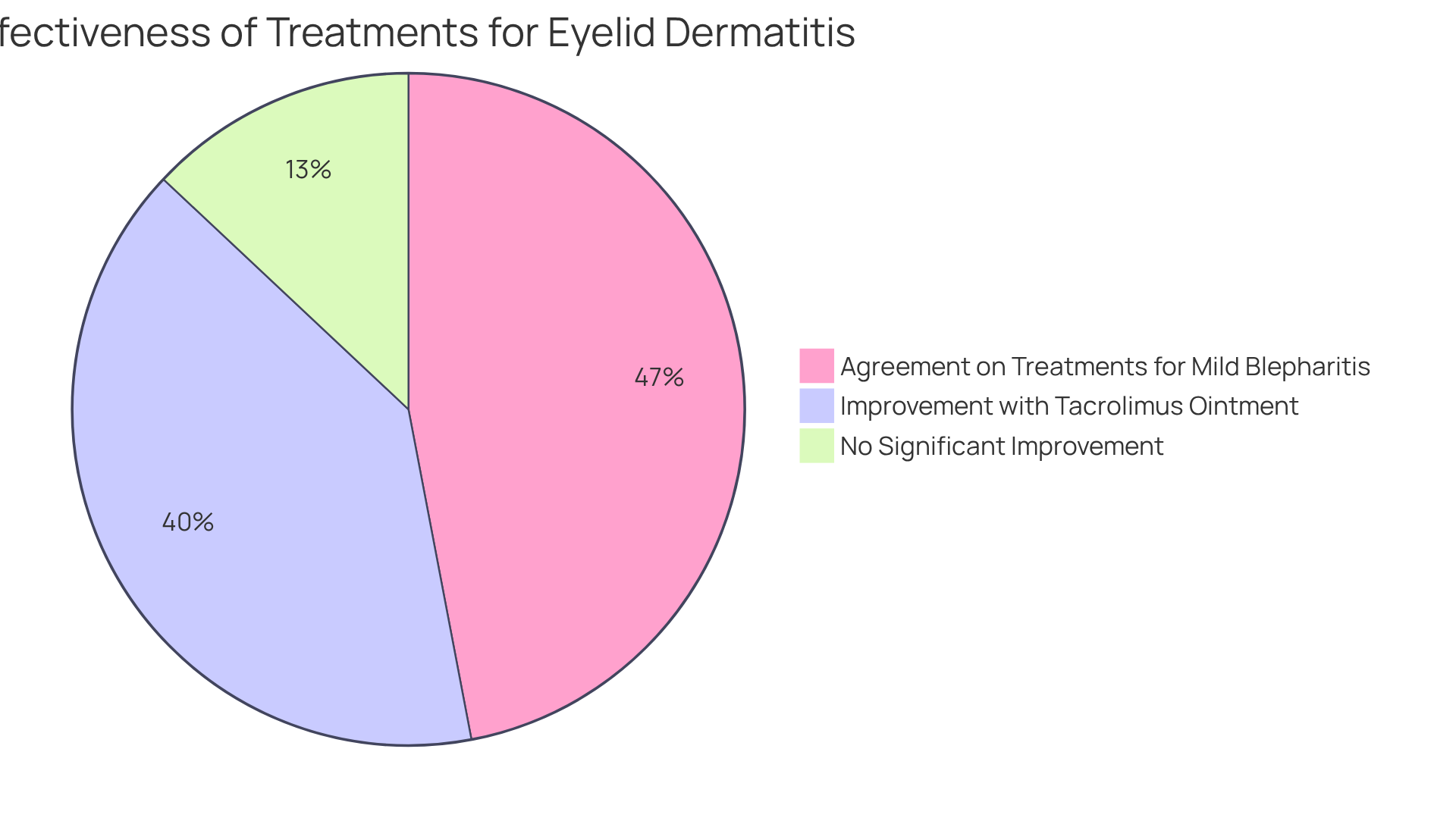
Avoid Irritants: Eliminate Common Products That Aggravate Symptoms
Managing can be challenging, and we understand how concerning this condition can be for you. It’s important to be vigilant about the products you use. Fragrances, alcohol, and harsh chemicals are . Many individuals with delicate complexions report reactions to these ingredients, highlighting the importance of carefully scrutinizing labels.
Choosing is crucial for effective eyelid dermatitis treatment, as these formulations are specifically designed to minimize irritation and allergic responses. Even ingredients that seem harmless can provoke reactions, so selecting products that prioritize your skin’s health is essential.
Symptoms of irritant contact dermatitis may include:
- Itchy areas
- Rashes
- Flaking or peeling skin
- , nose, and mouth
We also want to remind you that avoiding excessive rubbing or touching of the eyes can further reduce irritation and promote healing.
By adopting strategies such as and using , you can significantly alleviate your symptoms and enhance your overall complexion, which is essential in eyelid dermatitis treatment. Remember, we are here to help you through this process and .
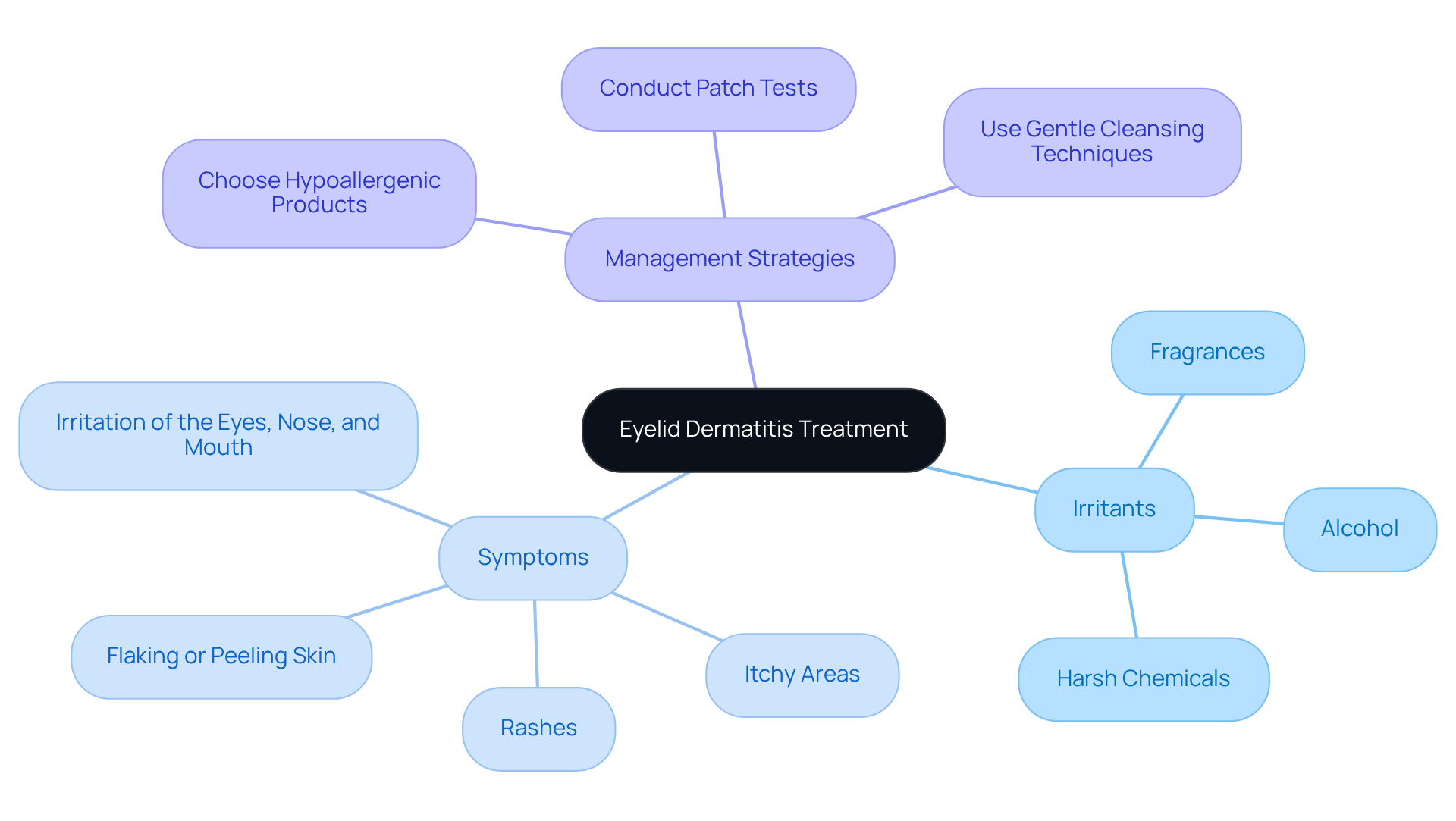
Implement Lifestyle Changes: Enhance Overall Skin Health
Implementing lifestyle changes, such as a , regular exercise, and , can significantly enhance the of your complexion. We understand that making these adjustments can feel overwhelming, but incorporating foods rich in , like fish and flaxseeds, can promote moisture retention and decrease inflammation, which is essential for your skin’s vitality.
It’s common to feel stressed, and practicing like yoga or meditation can help minimize flare-ups related to stress. Remember, maintaining adequate hydration by consuming 8-10 glasses of water each day is crucial for promoting the health of your dermis. We want you to feel empowered in your journey towards .
Moreover, acknowledging the impact of stress on dermal health is vital. Elevated cortisol levels can worsen cutaneous problems, so understanding this connection is crucial for developing a to manage conditions such as . We are here to help you through this process and support you in .

Stay Hydrated: Importance of Moisture for Skin Recovery
Staying hydrated is essential for maintaining elasticity in the dermis and preventing dryness, especially for those in need of . We understand that can be challenging, and dermatologists typically recommend an average water intake of about 2 to 3 liters per day, depending on individual needs and activity levels. To enhance hydration, consider practical strategies like:
- Carrying a water bottle to encourage regular drinking
- Using a humidifier in dry environments to add moisture to the air
Using a right after cleansing is another effective way to retain moisture and support your body’s natural barrier. This practice not only helps in keeping your skin hydrated but also encourages recovery of the dermis. As one dermatologist wisely notes, ‘ are essential for individuals with eye area conditions, as they can greatly enhance texture and comfort.’ By prioritizing , you can significantly improve your skin’s resilience and . Remember, we are here to help you through this process.
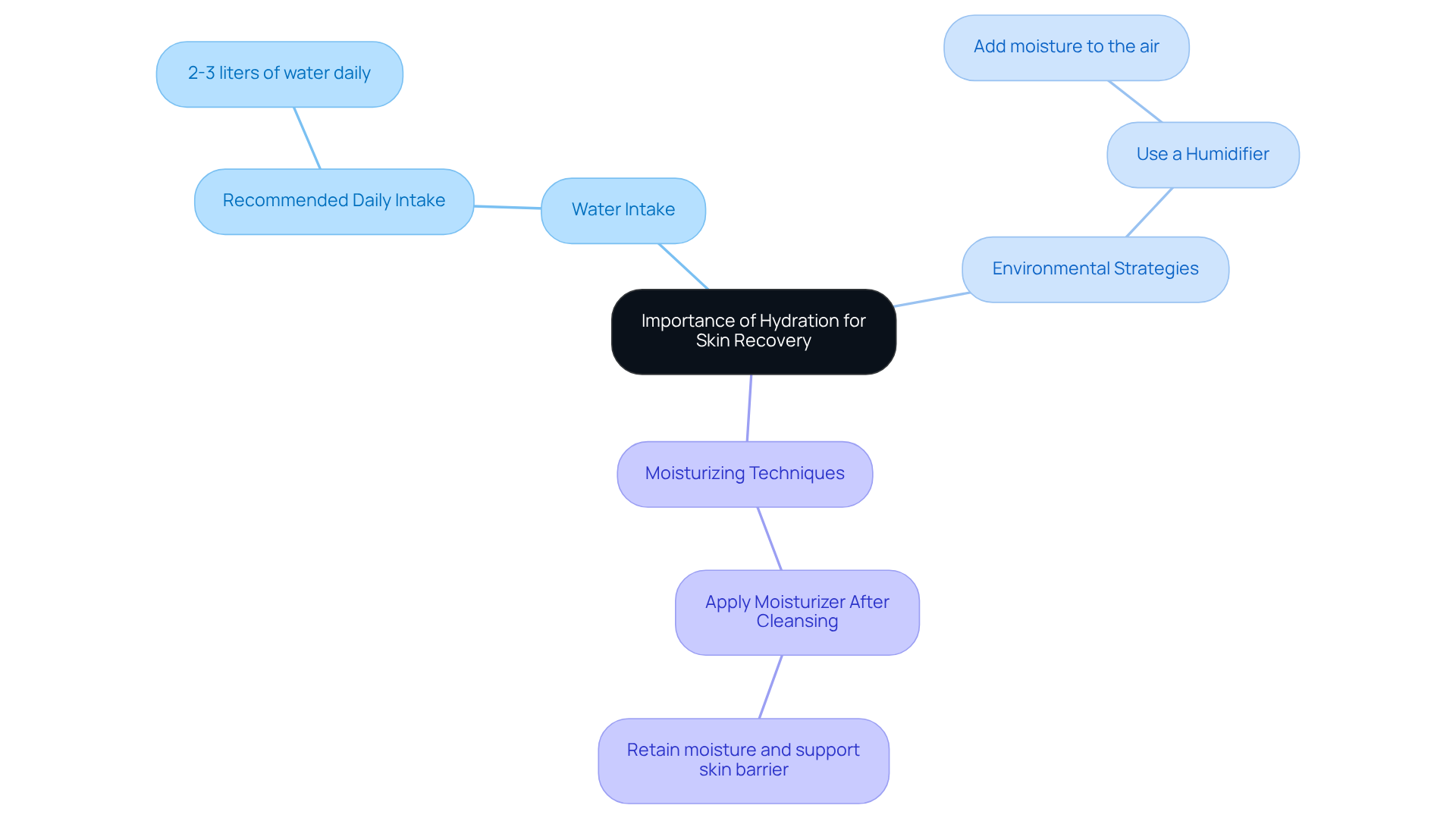
Consider Allergy Testing: Identify Specific Sensitivities for Better Management
For those facing persistent , we understand that navigating your sensitivities can be challenging. Allergy testing can play a vital role in that may not be immediately apparent. This process often reveals hidden triggers, empowering you to adopt more . Research shows that successful identification of sensitivities through has yielded positive results in 47% to 88% of cases, though it’s important to note that variability exists, with positive results ranging from 13% to 88% across different studies.
can provide you with crucial insights into your sensitivities, enabling for eyelid dermatitis treatment that significantly enhance your outcomes. Specialists emphasize that understanding your personal allergen profile is essential for effective eyelid dermatitis treatment, as it helps to address the complexities of skin conditions and promotes overall . However, we want you to be aware that patch testing may necessitate multiple visits and could lead to some irritation at the testing sites.
Furthermore, if your patch testing results are affirmative, employing directed is vital. This ensures a , providing you with the best possible care. Remember, we are here to help you through this process, and your journey towards improved skin health is important to us.
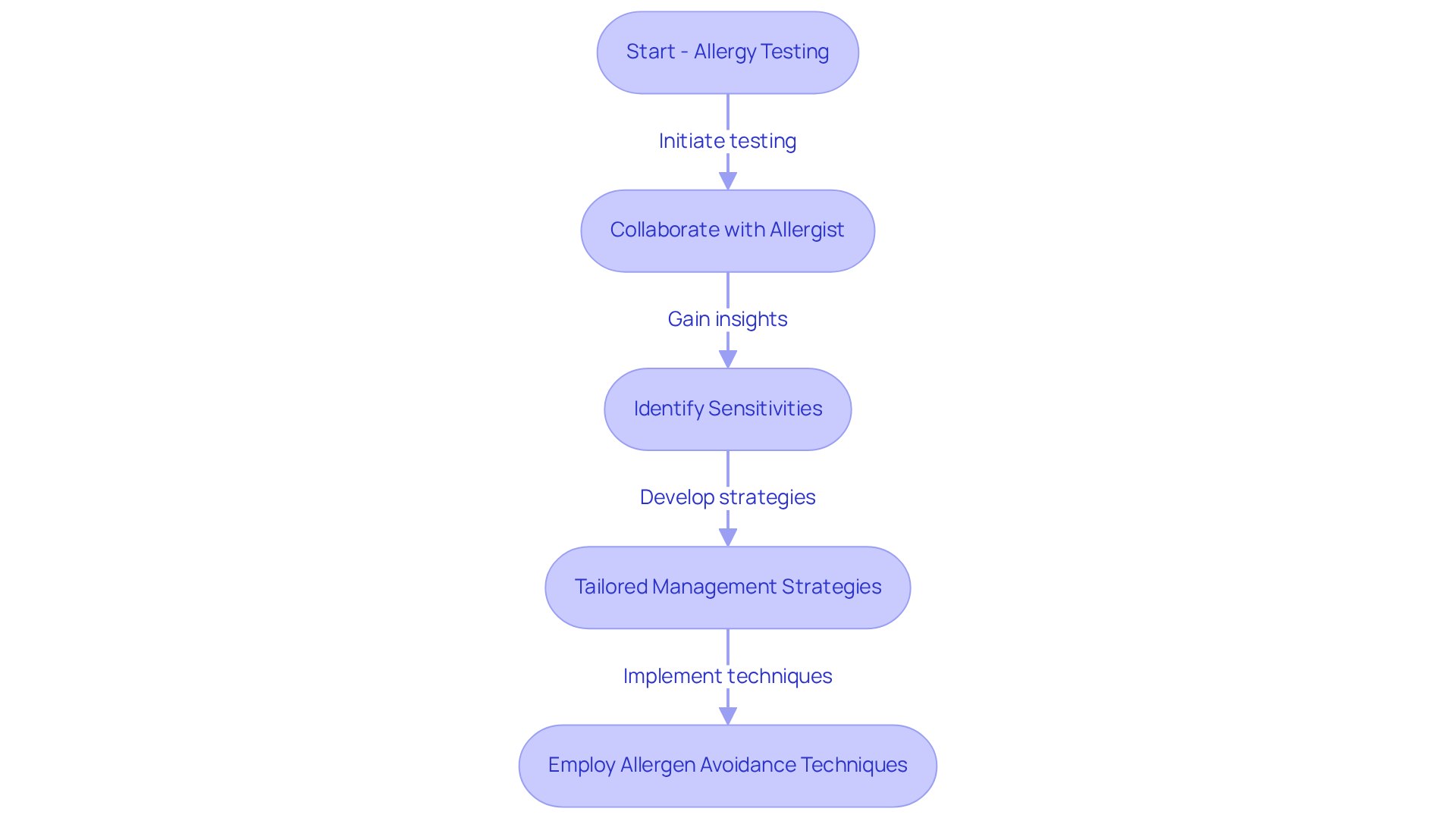
Educate Yourself: Understand Eyelid Dermatitis for Better Management
Understanding is an important step towards . We know that dealing with this condition can be challenging, and seeking is essential. Medical websites and literature can provide into the causes and options that are available. It’s common to feel overwhelmed, but engaging in discussions with your can enhance your understanding and lead to better . Remember, you are not alone in this journey—we are here to help you through it.
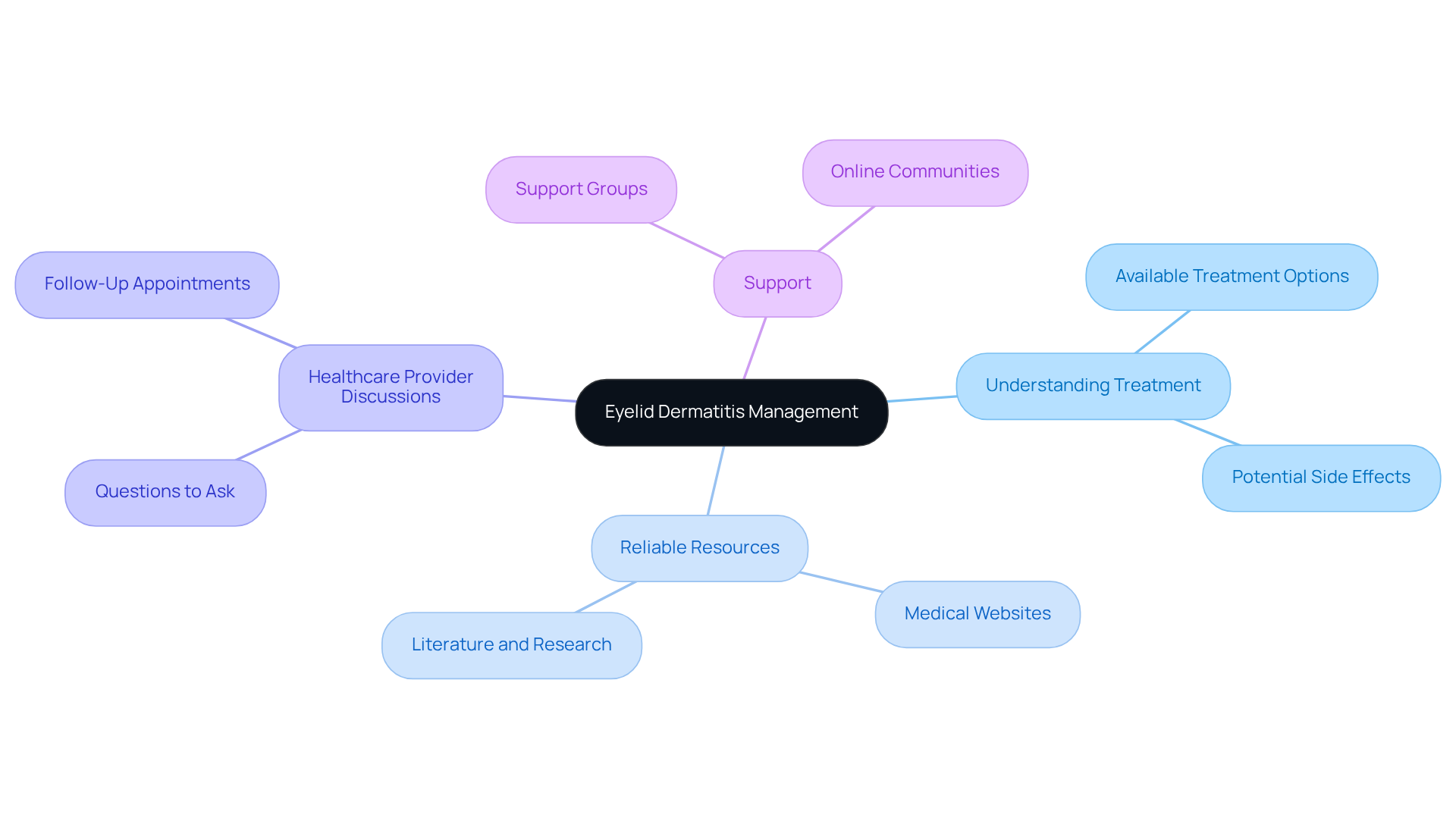
Conclusion
Eyelid dermatitis can indeed be a frustrating condition, but effective management is within your reach through personalized care, lifestyle adjustments, and professional guidance. We understand that recognizing the triggers and implementing a tailored treatment plan can significantly improve your symptoms, allowing you to regain control over your skin health.
Key strategies involve:
- Identifying allergens
- Establishing a gentle skincare routine
- Consulting dermatologists for expert advice
- Utilizing appropriate topical treatments
- Avoiding irritants
Additionally, making lifestyle changes—such as enhancing hydration and managing stress—can further support your skin recovery. Each of these elements is crucial in developing a comprehensive approach to treating eyelid dermatitis.
Ultimately, becoming informed about eyelid dermatitis and actively engaging in your treatment can lead to a healthier complexion and an improved quality of life. By prioritizing education and collaborating with healthcare professionals, you can navigate this journey with confidence, ensuring that your unique needs are met and that you find effective relief from this challenging condition.
Frequently Asked Questions
What services does Northwest Eye offer for eyelid dermatitis management?
Northwest Eye provides comprehensive eyelid dermatitis management services, combining advanced diagnostic tools with tailored treatment plans specifically designed for eyelid dermatitis.
How does Northwest Eye approach patient education regarding eyelid dermatitis?
Northwest Eye believes in empowering patients through education, helping them understand their condition and available treatment options to foster a collaborative approach to eye health.
What are common allergens that can trigger eyelid dermatitis?
Common allergens that may trigger eyelid dermatitis include cosmetics, skincare products, and environmental factors such as pollen or pet dander.
How can I identify specific allergens that affect my eyelid dermatitis?
Keeping a diary of your symptoms and potential triggers can help identify specific allergens. Consulting with a healthcare provider can also provide valuable insights and help develop management strategies.
What skincare practices are recommended for managing eyelid dermatitis?
It is recommended to establish a gentle skincare routine using mild, fragrance-free cleansers and moisturizers formulated for delicate skin. Avoid harsh scrubs and consider using a soothing eye cream to enhance moisture retention.
Why is consistency important in managing eyelid dermatitis?
Consistency in using gentle skincare products is key to managing sensitivity and effectively treating eyelid dermatitis, helping to reduce the likelihood of flare-ups.






